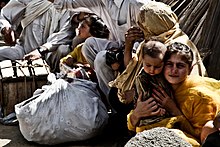User:Joycelivmarshall/Humanitarian crisis
Appearance
Categories
[edit]
There is no simple categorization of humanitarian crises. Different communities and agencies tend to have definitions related to the concrete situations they face. A local fire service will tend to focus on issues such as flooding and weather induced crises. Medical and health related organizations are naturally focused on sudden crises to the health of a community. Humanitarian crisis may arise from both natural and man-made conflicts and disasters. Humanitarian crisis from natural disasters include tsunami, earthquake, hurricane, floods, droughts, and wildfires that may result in disruption through damage to property, physical injury and death, psychological distress, displacement of individuals and families, and prolonged disruption in normal daily activities. On the other hand, crisis from manmade disasters such as wars, social unrest, protests, conflicts, and terrorist attacks have a broad range of impacts on the physical, mental, and social well-being of the individuals affected.[1] An ongoing or lingering pandemic may amount to a humanitarian crisis, especially where there are increasing levels of virulence, or rates of infection as in the case of AIDS, bird flu or tuberculosis. Major health-related problems such as cancer, global warming typically require an accentuated or punctuated mass-event to justify a label of "crisis" or "disaster". The International Federation of Red Cross and Red Crescent Societies (IFRC) lists categories which include different types of natural disasters, technological disasters (i.e. hazardous material spills, Chernobyl-type nuclear accidents, chemical explosions) and long-term man-made disasters related to "civil strife, civil war and international war".[2] Internationally, the humanitarian response sector has tended to distinguish between natural disasters and complex emergencies which are related to armed conflict and wars.[3]
[edit]Impacts
[edit]Women's social status in humanitarian crises
[edit]
Socially, women and children (mostly girls) receive a significantly decreased amount of attention in response to humanitarian crises. Women and children make up 3 quarters of refugees or displaced persons at risk post-crisis. A quarter of this population is of reproduction age and a fifth of this population is likely to be pregnant. In times of emergency and such crises, deaths associated with pregnancy, reproductive health, sexual violence and sexual exploitation increase drastically especially amongst females. During such emergencies, women lose access to family planning services, prenatal care, postpartum care and other health services. The heightened risk of female health and safety makes them vulnerable to disease, violence and death.[4] Non-profit organizations such as the Women's Refugee Commission deal with aiding particularly women suffering from various types of humanitarian crises.[5] According to the Women's Refugee Commission, during the first hours of a humanitarian crisis, women and young children are at most risk. During such an event, agencies and organizations approach matters variably. However, the top critical requirements within hours and months of the crises include: keeping the refugees and internally displaced persons away from danger, allowing access to fundamental needs such as food and healthcare, identification information, preventing sexual violence and others.[6]
[edit]- ^ Cueto, Lavinia Javier; Agaton, Casper Boongaling (2021). "Pandemic and Typhoon: Positive Impacts of a Double Disaster on Mental Health of Female Students in the Philippines". Behavioral Sciences. 11 (5): 64. doi:10.3390/bs11050064. PMC 8147095. PMID 33946801.
- ^ "Types of disasters: Definition of hazard". ifrc.org. Retrieved 11 May 2020.
- ^ Office for the Coordination of Humanitarian Affairs handbook for complex emergencies
- ^ "UNFPA – United Nations Population Fund – Protecting Women in Emergency Situations". unfpa.org. Retrieved 9 February 2015.
- ^ Matthew Mesa. "Women's Refugee Commission – Humanitarian Crises Around the World". womensrefugeecommission.org. Retrieved 9 February 2015.
- ^ Caitlin Kelley. "Women's Refugee Commission – Top 10 Needs Facing Refugees and Those Displaced in Emergencies". womensrefugeecommission.org. Archived from the original on 9 February 2015. Retrieved 9 February 2015.
